Driving Europe’s transition to clean, connected, and resilient urban mobility
Cities across Europe are redesigning their transport systems to achieve climate neutrality, improve accessibility, and enhance quality of life. Urban mobility is not just about moving people and goods, it shapes how we live, interact, and breathe in our cities. A sustainable, inclusive and resilient mobility system combines infrastructure, policy, technology, and behavioural incentives. This page organises mobility & transport along five core action areas, supplemented by key definitions, focus topics, and case studies.
Why mobility matters for cities & climate neutrality
-
The transport sector is a major source of greenhouse gas emissions and air pollution in urban areas. Transforming mobility is essential to meet climate neutrality goals.
-
-
Sustainable mobility enhances urban liveability, equity, inclusion, public health, and economic resilience, especially in densely populated or expanding cities.
-
Sustainable mobility also improves urban health by reducing air and noise pollution exposure.
-
With the support of programmes like NetZeroCities and the EU Cities Mission, cities have access to practical tools, funding, peer-learning and guidance to implement systemic mobility transitions.
-
By integrating energy, spatial planning, and citizen engagement, cities are not just moving people, they are redefining urban life.
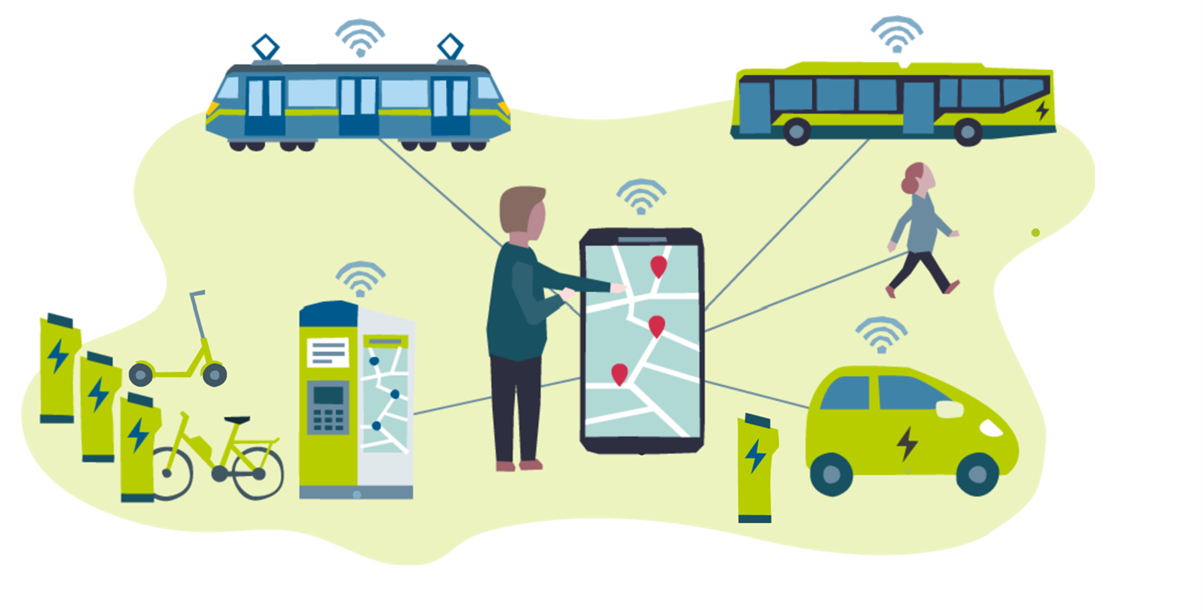
-
INFRASTRUCTURE AND PUBLIC SPACE REDESIGN
Reimagining streets, public space and urban fabric to prioritise people, not cars.
Integrating land-use planning with mobility encourages modal shift: fewer car trips, more walking, cycling, public transport. This reduces emissions, improves air quality, and enhances urban liveability. Public space redesign can help restore green corridors, improve accessibility, and create safer, more inclusive neighbourhoods.
Core strategies & concepts:
- Mixed-use & transit-oriented planning: combining land-use and mobility planning to reduce travel needs.
- Active mobility infrastructure: cycling lanes, pedestrian zones, safe crossings, and public realm design for non-motorised transport.
- Micromobility: lightweight, short-distance modes (e-scooters, shared bikes, pedelecs) that complements public transport and walking.
- Universal accessibility and noise mitigation: ensuring mobility systems are inclusive, comfortable, and healthy for all citizens.
- Road safety and Vision Zero principles: safe crossings, speed limits, protected lanes, and smart systems designed to eliminate road fatalities.
- Urban regeneration: redesigning underused spaces and integrating greenery, public furniture, and accessibility for improved liveability.
- Demand-responsive transport (DRT): flexible, data-driven public transport for inclusive accessibility.
Use cases:
- Superblocks Vitoria-Gasteiz (Spain): restructuring neighbourhoods to prioritise pedestrians, cyclists, and public transport, cutting car use by 40%.
- Paris 15-Minute City (France): integrating land use and mobility for self-sufficient neighbourhoods that reduce travel demand.
- Prague (Czech Republic) “Towards Low Carbon Transport in Prague”: redesigned streets, intermodal hubs, and cycling infrastructure to reduce car dependency.
- Lisbon (Portugal) “Green Participatory Budget”: co-created projects for bike lanes, green corridors, and inclusive public spaces.
- Cluj-Napoca (Romania) “Circular Mobility Innovation LGD”: using recycled materials for transport infrastructure through public-private partnerships.
Explore resources:
- Efficient and sustainable urban goods delivery using cargo-bikes, e-vans, and smart routing.
- Urban Rail
- Integrated land use planning and urban space management with mobility planning
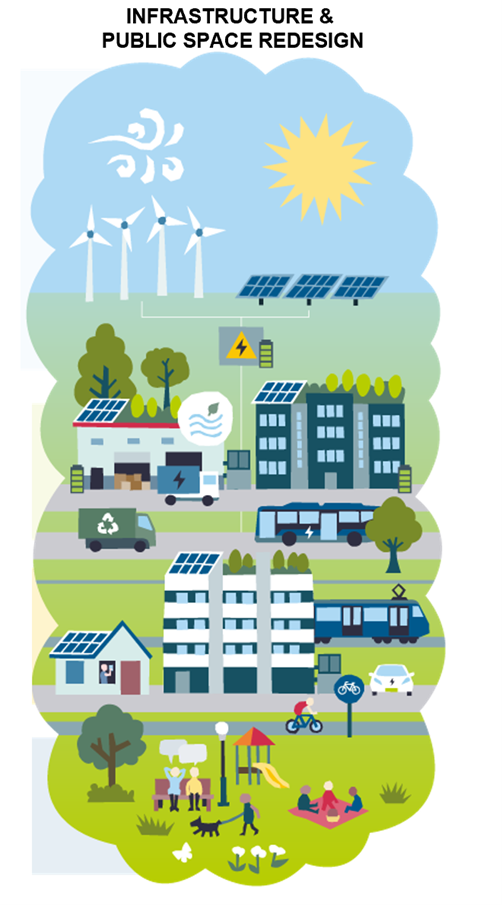
Cities are increasingly designing streets as public spaces — where active mobility, greenery, and climate adaptation meet.
ELECTRIFICATION AND SUSTAINABLE MOBILITY
Transitioning to clean, low-carbon transport through electric and zero-emission solutions.
The electrification of transport is central to achieving net-zero goals.
Cities are deploying clean fleets, expanding charging networks, and integrating renewable energy systems.
Electrified passenger transport (EVs, electric buses, zero-emission vehicles) eliminates tailpipe emissions (CO₂, NOₓ, PM), significantly reducing air pollution and climate impact. When paired with clean electricity and circular battery lifecycles, electrification becomes a cornerstone of urban sustainability.
Core strategies & concepts
- Zero-emission buses, coaches, and vehicles: transforming urban fleets for public and private transport.
- Public charging infrastructure: accessible, efficient charging stations for EVs (cars, buses, cargo, vessels), including fast chargers, depot charging, and networked charging.
- Bi-directional charging / V2X (vehicle-to-grid / vehicle-to-building): enabling EVs to stabilise the grid and renewable energy integration.
- Electrification of municipal fleets & services: reducing emissions from public administration, waste collection, and utilities.
- Electric cargo bikes and micromobility for last-mile, freight and logistics: powering last-mile logistics with zero-emission alternatives.
- Zero-emission vessels / maritime electrification: for port cities and coastal mobility, extending decarbonisation beyond land transport.
- Alternative fuels (biofuels, e-fuels, hydrogen): transitional low-carbon solutions for heavy-duty and long-distance transport.
Use cases:
- Tauragė (Lithuania): electrified, fare-free bus network with integrated ticketing across municipalities.
- Castelo Novo (Portugal): rural e-mobility network connecting heritage villages to train stations.
- Pau (France) “FÉBUS Hydrogen Bus Project”: deployment of hydrogen-powered buses and local hydrogen production infrastructure.
- Galați (Romania) “Green Transit Revolution”: electrification of bus and tram fleets with charging infrastructure and citizen awareness campaigns.
- Esch-sur-Alzette (Luxembourg) promoting cargo bikes and solar-integrated EV charging for zero-emission transport.
Explore resources:
- Zero-emission buses
- Zero-emission electric cars
- Public charging systems for EVs
- Bi-directional EV charging (V2X)
- Zero emission vessels - Reduce emissions in ports
- Blended Finance (EU) – BABLE Smart Cities: joint procurement model enabling affordable EV infrastructure investments.
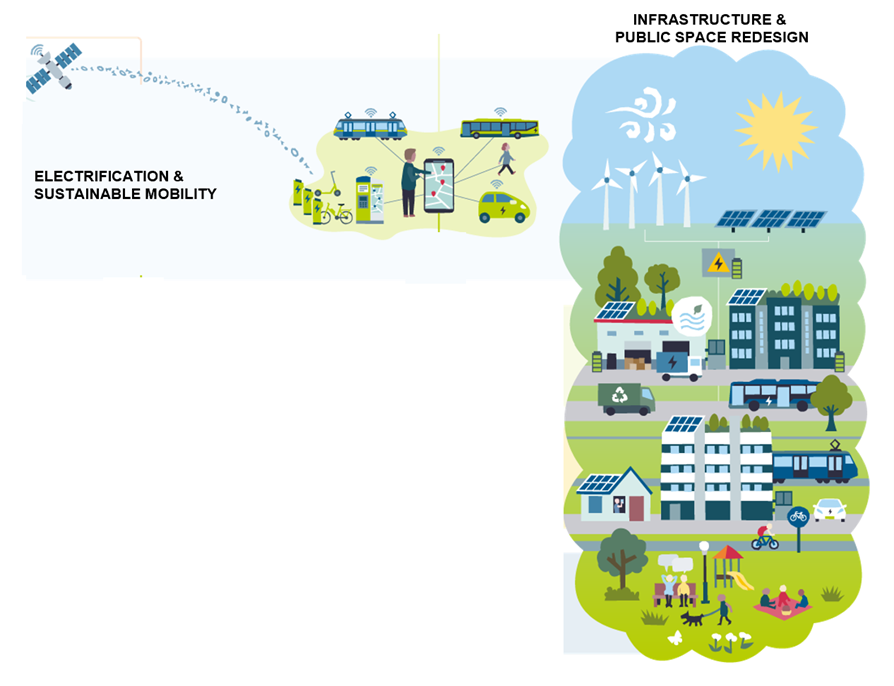
Electrification is more than technology — it’s a redesign of urban energy systems, linking mobility with renewable energy and grid resilience.
BEHAVIOURAL & ECONOMIC INCENTIVES
Influencing how people choose to move, enabling sustainable mobility through incentives, awareness, and social innovation.
Infrastructure and regulation alone are insufficient if people continue car-dependent habits. Behavioural change (supported by incentives, accessibility, social innovation) is essential for long-term modal shift and decarbonisation. Cities are promoting active mobility, behavioural nudges, awareness campaigns, and community-based programmes to promote sustainable mobility.
Core strategies & concepts
- Active mobility & awareness campaigns: promoting walking, cycling, and micromobility through safe infrastructure and communication.
- Shared mobility & carpooling / ridesharing: reducing individual car ownership and use, and optimising occupancy.
- Public transport incentives & inclusive pricing: affordable fares, subsidies for low-income or vulnerable groups, making public transport affordable and accessible.
- Employer and corporate mobility management: incentivising modal shift for commuting (public transport pass, bike-to-work schemes, mobility allowance).
- Education & community engagement: raising awareness on environmental and health benefits, co-creation of mobility plans involving citizens (e.g., participatory planning, community-based mobility solutions).
Use cases:
- Lahti (Finland): employer partnerships and incentives shifting commuting from cars to bikes and PT.
- Helsinki (Finland) Ride-Sharing Service for Schoolchildren: community-driven shared mobility model.
- Vitoria-Gasteiz (Spain) Shared Mobility Pilot: industrial park car-pooling scheme reducing 11 tonnes CO₂ in four months.
- Porto (Portugal) “Climate Impact of Mobility”: modal shift, free public transport for children, and fleet electrification to engage citizens.
- Campobasso (Italy) “School Mobility 2030 & Business Shuttle Plan”: incentives for low-emission commuting and awareness among students and companies.
- Câmara de Lobos (Portugal) “Festa de São Pedro – Mobilidade Sustentável”: circular public transport for events fostering behavioural change.
- Ioannina (Greece): co-created climate-neutral zones integrating mobility and urban planning.
Explore resources:
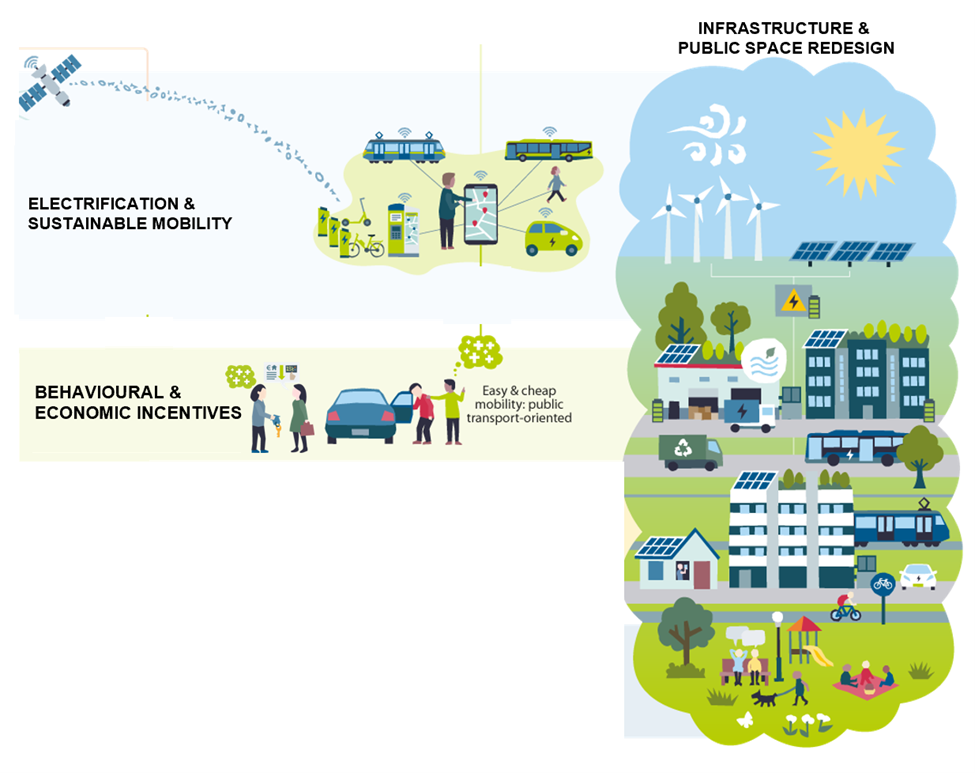
Behavioural innovation complements technology by turning sustainable travel into the natural, easy, and desirable choice.
MOBILITY & LOGISTICS MANAGEMENT AND OPTIMISATION
Using data, technology, and systemic planning to optimise how people and goods move.
Efficient mobility systems enhance accessibility while reducing environmental impacts. Cities increasingly rely on digital twins, AI analytics, and real-time data to optimize transport flows, support modal integration, and optimise logistics.
Core strategies & concepts
- Multimodality and Mobility as a Service (MaaS): combining public transport, shared mobility, micromobility, to offer seamless door-to-door journeys.
- Multimodal ticketing & smart cards, electronic ticketing: simplifying transfers among modes, improving user convenience, enabling fare integration.
- Mobility hubs / intermodal interchanges: nodes integrating various transport modes (public transport, bikes, EV charging, shared mobility), enabling efficient modal shift.
- Urban freight & last-mile logistics: electrified delivery fleets, cargo bikes, smart routing, and drone-assisted systems.
- Connected, Cooperative & Automated Mobility (CCAM) and future-oriented systems: exploring automation, self-driving, shared fleets, dynamic routing for passenger and freight transport.
- Digital platforms & smart city data systems: using open data, IoT, digital twins, traffic monitoring and real-time management to optimise mobility flows and adapt to demand.
- Digital infrastructure and cybersecurity: reliable, secure data systems supporting transport operations.
- Urban Air Mobility (UAM): testing eVTOL and aerial logistics solutions.
Use cases:
- Kranj (Slovenia): Multimodal MaaS digital platform integrating public transport, shared mobility, and cycling.
- Busto Arsizio (Italy) “Smart Mobility for EcoCommuting”: mobile app–based gamified system encouraging sustainable commuting.
- Gdańsk (Poland) “Smart Mobility and Real-Time Parking Integration”: reduced congestion and promoted modal shift using digital data.
- Alba Iulia (Romania) “Digital Twin and Data Sharing Frameworks”: connecting transport operators for smarter mobility planning.
- Helmond (Netherlands) Urban Strategy: digital twin and data-driven management for resilient urban transport.
Explore resources:
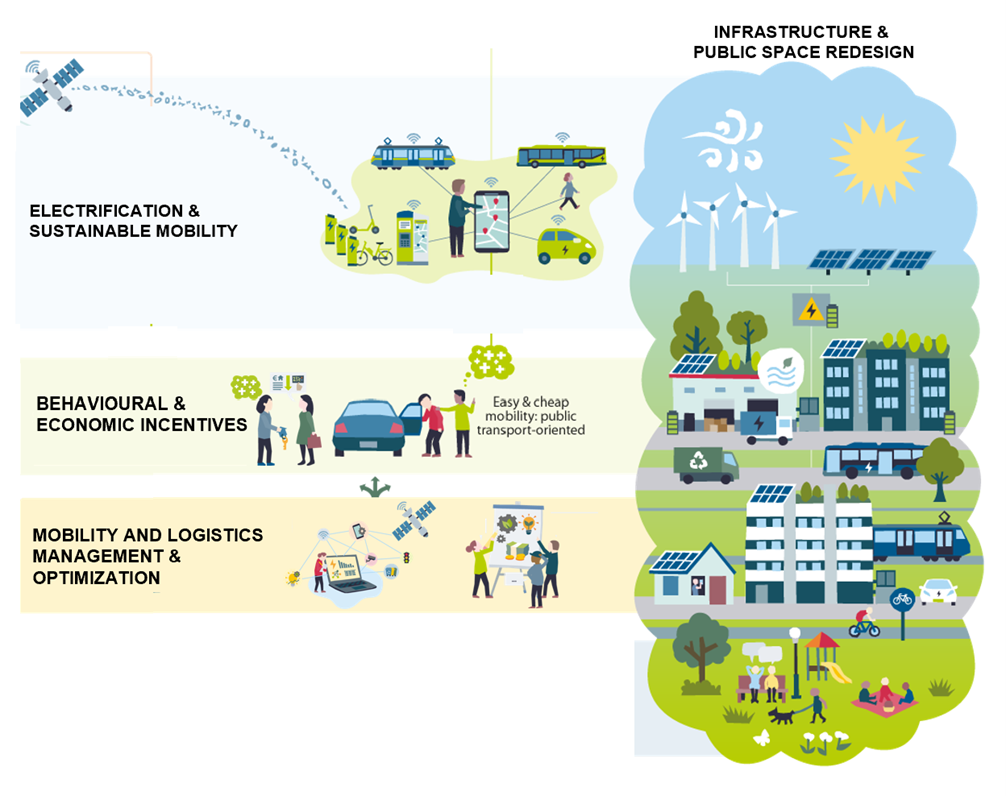
Integrated data systems enable cities to balance efficiency, inclusivity, and sustainability in real time.
REGULATION & POLICY FRAMEWORKS
Governance instruments that enable, guide, and regulate sustainable mobility transitions.
Transforming mobility requires more than infrastructure — it needs coherent planning, regulation, and participatory governance.
Cities are adopting flexible, multimodal regulatory frameworks that balance accessibility, safety, and climate objectives.
Core instruments & concepts
- Sustainable Urban Mobility Plans (SUMPs), Sustainable Urban Logistic Plans (SULPs): citywide frameworks combining infrastructure, policy, public transport, walking, cycling, and logistics under shared governance.
- Urban Vehicles Access Regulation (UVAR), Low-Emission Zones (LEZs): to control car access, reduce congestion and pollution, and reallocate street space.
- Cooperative / Intelligent Transport Systems (C-ITS / ITS): using telematics and real-time data for smart parking, multimodal management, and traffic optimisation.
- Parking policies & Smart parking management: dynamic pricing, digital parking data, restricted parking zones, and integration with mobility hubs to discourage private car use and support shared mobility.
- Congestion pricing & access regulation: economic and regulatory measures to limit private car use in dense urban areas, encourage modal shift, and reduce pollution and congestion.
- Subsidies & incentives: local/national schemes to support EV purchase, fleet electrification, cargo-bike adoption, shared mobility, lowering barriers to sustainable transport.
- Sustainable tourism mobility: decarbonising visitor travel through low-emission transport.
- Inclusive planning & equity considerations: ensuring accessibility for all users and addressing mobility needs e.g., gender-sensitive mobility planning, social inclusion, integration of different population groups (elderly, youth, low income).
Use cases:
- London (UK) “Ultra-Low Emission Zone (ULEZ)”: regulation to reduce air pollution and promote EV adoption.
- Benidorm (Spain) “Sustainable Urban Mobility Plan (PMUS)”: introduced LEZs, electric buses, and park-and-ride facilities.
- Kozani (Greece) “Smart Mobility Pact”: digital parking, awareness campaigns, and alignment with the city’s SECAP.
- Ghent (Belgium) “NEUTRALPATH City Profile”: climate-neutral governance integrating mobility, policy, and stakeholder engagement.
- Oslo (Norway) Sustainable Procurement Strategy: embedding climate and mobility sustainability into city purchasing.
- Ioannina (Greece): demonstrates participatory co-creation in defining policy for climate-neutral zones.
- Braga (Portugal) – Sustainable Urban Mobility LGD: integrated low-emission zones and intelligent transport systems.
Explore resources:
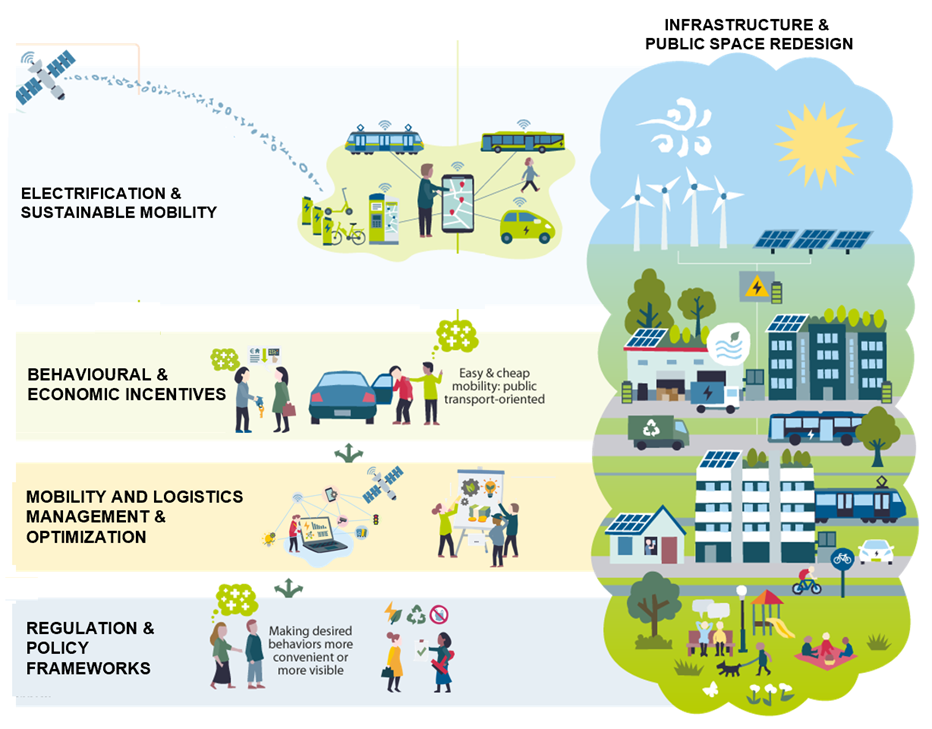
Effective regulation is the backbone of climate-neutral mobility — guiding investment, ensuring equity, and protecting public space.
KEY DEFINITIONS AND CONCEPTS:
|
Term / Concept |
What it means / Why it matters |
|
|
Micromobility |
Light, human- or electric-powered mobility modes (e-scooters, shared bikes, pedelecs), especially useful for short trips / “last mile” connections. |
|
|
SUMP/SULP |
Strategic, multimodal urban mobility frameworks integrating transport, logistics, and land use. |
|
|
C-ITS (Cooperative Intelligent Transport Systems) |
Use of real-time communication, data, and telematics to manage traffic, parking, and multimodal integration efficiently. |
|
|
CCAM |
Connected and automated mobility integrating real-time data and shared fleets. |
|
|
Modal shift: Avoid / Shift / Improve |
Avoid unnecessary trips, shift to sustainable modes, and improve efficiency of remaining transport. |
|
|
Multimodality / MaaS |
|
|
|
Last-mile logistics |
Sustainable management of freight and goods movement in cities (via cargo-bikes, e-vans, optimised routing, smart logistics) to reduce congestion and emissions. |
|
|
Parking management |
Regulating parking supply, pricing, and land use to discourage private car use, reduce congestion, and free up space for public realm / mobility alternatives. |
|
|
Congestion Pricing / Access Regulation |
Economic or regulatory measures to limit car use in dense/central areas, discouraging single-occupancy vehicles, reducing pollution and promoting modal shift. |
|
|
Electrification & Alternative Fuels |
Transition from fossil-fuelled vehicles to electric or zero-emission vehicles (passenger, freight, public transport), supported by charging infrastructure, policies and clean energy. |
|
|
Behavioural & Economic Incentives |
Measures aimed at changing user behaviour: subsidies, incentives, awareness campaigns, employer mobility schemes, inclusive pricing — to promote sustainable mobility adoption. |
|
|
Mobility Data Management |
Use of real-time data for planning, monitoring, and optimization. |
|
|
Urban Air Mobility |
Use of eVTOL and drone-based logistics for urban transport. |
|
|
Digital Infrastructure & Cybersecurity |
Secure networks (5G, IoT, cloud) enabling connected mobility. |
Comments ()